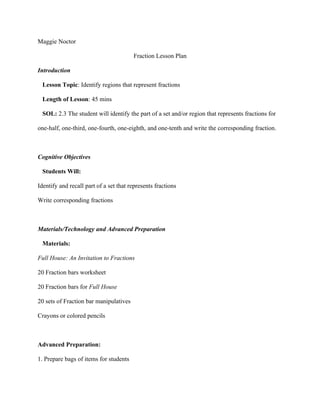
Fraction lesson plan
- 1. Maggie Noctor Fraction Lesson Plan Introduction Lesson Topic: Identify regions that represent fractions Length of Lesson: 45 mins SOL: 2.3 The student will identify the part of a set and/or region that represents fractions for one-half, one-third, one-fourth, one-eighth, and one-tenth and write the corresponding fraction. Cognitive Objectives Students Will: Identify and recall part of a set that represents fractions Write corresponding fractions Materials/Technology and Advanced Preparation Materials: Full House: An Invitation to Fractions 20 Fraction bars worksheet 20 Fraction bars for Full House 20 sets of Fraction bar manipulatives Crayons or colored pencils Advanced Preparation: 1. Prepare bags of items for students
- 2. 2. Fill each plastic bag with one set of Fraction bar manipulatives 3. Prepare the fraction bars for Full House: An Invitation to Fractions 4. Print a rectangle then draw five equal distance lines, so that the rectangle is split into six equal spaces. 5. Make sure crayons or colored pencils are in easily assessable area for students that may need them. Teaching and Learning Sequence Introduction/Anticipatory Set: • Take out Full House: An Invitation to Fractions book from front desk • Read Full House: An Invitation to Fractions by Dayle Ann Dodds • Hand out to students fraction bar. • Tell students we are going to reread the story, but this time they should color in the spaces on the bar a different color each time a different guest moves in. • As you reread the story make sure students have enough time to color each bar as the guests move in. • Stop periodically and ask students how many bars are filled and how many rooms are still open. Lesson Development: • Talk with student about what they have just done. • Talk about the first block on the bar, how many rooms is that person filling up out of all the rooms in the house?
- 3. • Ask students if they see any patterns or anything that is the similar for all the rooms in the house? Ask about how many rooms are filled when the second person comes in? Continue until you have talked about all six rooms in the house. • Write on the board the different fractions that the class has now colored onto their bars. • Explain to students that fractions are a very basic part of everyday life and you run across them every day without even realizing you do. • Talk about how the pie was split into pieces, and what else are commonly cut into equal pieces and how many pieces there are. • Have students work in groups of two or three at their tables • Pass out fraction worksheet and manipulative • Each group of two or three should one set of ________ those stick things we use • Tell students they should work using the manipulative to fill out the worksheet. • Explain to students that in groups they are trying to figure out ways to split the manipulative into fractions, and what the fractions look like when splitting them. • Walk around the classroom to aid if groups need it. Closure: • When most groups have finished the worksheet have class come back together. • While students are picking up manipulatives, ask one student from each table to come up and draw their answer to number one on the board. • Talk with class about how all these answers could be right, and how some fractions can equal others as well. • Collect manipulatives and worksheets from students
- 4. • Tell students that there homework is to come in with a list of three things that they saw at home or in school that are divided equally into parts and how many equal parts they are divided into. Homework: Write a list of three things that are divided equally into parts and how many equal parts they are divided into. Assessment: Formative: • Listen to answers given during the review of rooms used in the book Full House: An Invitation to Fractions. Are the students naming correctly from the book or can they not correctly filling rooms? • Watch while students create and use their manipulatives; are they using the manipulatives to form fractions? Do they look confused or wait till after a classmate has helped? Summative: • Collect the worksheets from class and review to see if and where students may need help. • Collect the homework from tonight, look at the lists students have put together, do they understand that fractions must be equal parts? Or are they just naming things that are cut into pieces? References: Shannon, McManus. (2010-1996). Feast on Fractions. http://www.knowledge.state.va.us/cgi-bin/ lesview.cgi?idl=507.